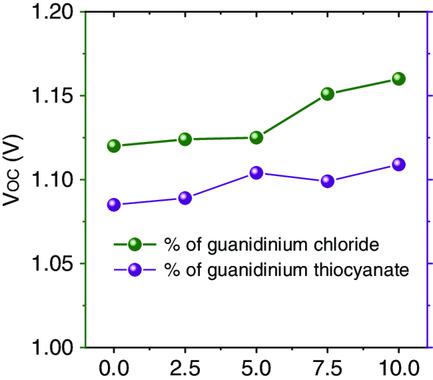Our official English website, www.x-mol.net, welcomes your
feedback! (Note: you will need to create a separate account there.)
Halide Versus Nonhalide Salts: The Effects of Guanidinium Salts on the Structural, Morphological, and Photovoltaic Performances of Perovskite Solar Cells
Solar RRL ( IF 6.0 ) Pub Date : 2019-07-26 , DOI: 10.1002/solr.201900234 Mohammad Hayal Alotaibi 1 , Yahya A. Alzahrani 1 , Neha Arora 2 , Ahmed Alyamani 1 , Abdulrahman Albadri 1 , Hamad Albrithen 1, 3 , Ibrahim H. Al-Lehyani 1, 4 , Sultan M. Alenzi 1 , Ali Z. Alanzi 1 , Fahad S. Alghamdi 1 , Shaik M. Zakeeruddin 2 , Simone Meloni 5, 6 , M. Ibrahim Dar 2 , Michael Graetzel 2
Solar RRL ( IF 6.0 ) Pub Date : 2019-07-26 , DOI: 10.1002/solr.201900234 Mohammad Hayal Alotaibi 1 , Yahya A. Alzahrani 1 , Neha Arora 2 , Ahmed Alyamani 1 , Abdulrahman Albadri 1 , Hamad Albrithen 1, 3 , Ibrahim H. Al-Lehyani 1, 4 , Sultan M. Alenzi 1 , Ali Z. Alanzi 1 , Fahad S. Alghamdi 1 , Shaik M. Zakeeruddin 2 , Simone Meloni 5, 6 , M. Ibrahim Dar 2 , Michael Graetzel 2
Affiliation

|
The impacts of halide and nonhalide sources of guanidinium cations, including guanidinium chloride (GCl) ((NH2)3CCl) and guanidinium thiocyanate (GTC) ((NH2)3CSCN), are comparatively analyzed on the structural, morphological, and photophysical properties of (CsMAFA)PbBrxI3 − x (x = 0.17) (MA = methylammonium, FA = formamidinium) perovskite films. X‐ray diffraction (XRD) reveals that the formation of photoinactive phases depends on the nature of counterions (halide vs nonhalide). Furthermore, morphological analysis shows that with the addition of guanidinium salts, the apparent grain size decreases due to the enhancement of nucleation density and/or slow growth of perovskite structures. More importantly, the introduction of GCl leads to the fabrication of perovskite solar cells (PSCs), yielding a photovoltage as high as 1.16 V (1.1 V for reference). In contrast, the introduction of GTC minimally affects the photovoltage, underlining the significance of counterions in improving the photovoltage of PSCs. The present preliminary results of the density functional theory based theoretical investigation related to the effect of G cation on the structure of the perovskite system is presented. In summary, the insights gained through structural and morphological characterization helps to understand the critical role of counterions of guanidinium salts in PSCs.
中文翻译:

卤化物与非卤化物盐:胍盐对钙钛矿型太阳能电池的结构,形态和光伏性能的影响
比较分析了胍盐阳离子的卤化物和非卤化物来源,包括氯化胍(GCl)((NH 2)3 CCl)和硫氰酸胍(GTC)((NH 2)3 CSCN)的结构,形态和(CsMAFA)PbBr x I 3 − x(x的 光物理性质= 0.17)(MA =甲基铵,FA =甲ami)钙钛矿薄膜。X射线衍射(XRD)表明,光惰性相的形成取决于抗衡离子的性质(卤化物与非卤化物)。此外,形态分析表明,由于添加了胍盐,表观晶粒尺寸由于钙钛矿结构的成核密度的增加和/或缓慢的生长而减小。更重要的是,GCl的引入导致钙钛矿太阳能电池(PSC)的制造,产生的光电压高达1.16 V(参考电压为1.1 V)。相反,GTC的引入对光电压的影响最小,强调了抗衡离子在提高PSC的光电压中的重要性。提出了目前基于密度泛函理论的初步结果,该理论研究涉及G阳离子对钙钛矿体系结构的影响。总之,通过结构和形态表征获得的见解有助于理解胍盐抗衡离子在PSC中的关键作用。
更新日期:2019-07-26
中文翻译:

卤化物与非卤化物盐:胍盐对钙钛矿型太阳能电池的结构,形态和光伏性能的影响
比较分析了胍盐阳离子的卤化物和非卤化物来源,包括氯化胍(GCl)((NH 2)3 CCl)和硫氰酸胍(GTC)((NH 2)3 CSCN)的结构,形态和(CsMAFA)PbBr x I 3 − x(x的 光物理性质= 0.17)(MA =甲基铵,FA =甲ami)钙钛矿薄膜。X射线衍射(XRD)表明,光惰性相的形成取决于抗衡离子的性质(卤化物与非卤化物)。此外,形态分析表明,由于添加了胍盐,表观晶粒尺寸由于钙钛矿结构的成核密度的增加和/或缓慢的生长而减小。更重要的是,GCl的引入导致钙钛矿太阳能电池(PSC)的制造,产生的光电压高达1.16 V(参考电压为1.1 V)。相反,GTC的引入对光电压的影响最小,强调了抗衡离子在提高PSC的光电压中的重要性。提出了目前基于密度泛函理论的初步结果,该理论研究涉及G阳离子对钙钛矿体系结构的影响。总之,通过结构和形态表征获得的见解有助于理解胍盐抗衡离子在PSC中的关键作用。











































 京公网安备 11010802027423号
京公网安备 11010802027423号